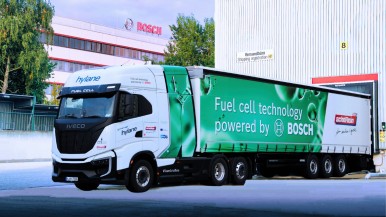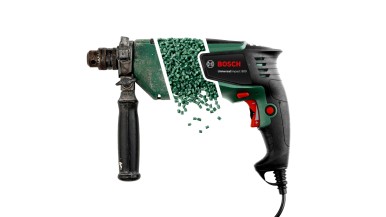Hannover, Germany – Bosch offers solutions that connect every stage of value creation: from suppliers through in-house manufacturing to customers. The sensors, software, services, and cloud provided by the broad-based supplier of technology meet all a company’s Industry 4.0 needs. Some examples of successful solutions and the benefits they bring:
Market launch: retrofit machine monitoring multisensor
Machine monitoring has never been so easy: a multisensor, or CISS device, is fitted to a moving part on the machine. Thanks to its robust housing, this sensor device is suitable for use in harsh industrial environments with heavy vibrations, soiling, or high temperatures. The machine data is sent via an IoT gateway to the cloud and processed in a transparent way for display on a dashboard. The real-time monitoring and comparison of machine data is thus possible at any time. In the event of irregularities, such as a machine that is vibrating too much, appropriate measures can be taken. This solution can also predict when maintenance will be necessary, before actual problems arise. Bosch has been successfully using the sensor in its plants for over two years.
Industry 4.0 app for workforce: Osram Ticketmanager
Bosch has connected over 80 different machines, some older than others, for the lighting manufacturer Osram in Berlin. The company’s plant for xenon lamps in Berlin now has an Osram Ticketmanager. In this way, Osram is helping its workforce put digital, flexible manufacturing into practice. The technology at the heart of this is the Bosch production performance manager (PPM) – a system that coordinates various streams of machine data in real time. The trick is to “translate” the data from various formats into a shared language, which turns it into useful information. Workers can now simply consult an app for a status report on their machinery. This presents a clear overview of any upcoming tasks, such as maintenance work or resupplying materials, allowing them to be organized and processed. The app provides access to all the information necessary for the key tasks. Having successfully concluded the project in Berlin, Osram will now roll the solution out to other plants.
New benefits thanks to connectivity: historic workbench with IoT gateway
It is 130 years old, pedal-powered, and a jewel of Industry 1.0. Robert Bosch, the company founder, himself worked at this cast iron workbench, which dates from 1887 and weighs 300 kilograms. Among other things, it was used to produce parts for the magneto ignition device, the product that helped the company to a breakthrough at the end of the 19th century. At one fell swoop, Bosch has now catapulted this historic workbench from the museum into the Industry 4.0 era – thanks to technological support from its new internet of things (IoT) gateway. The connected system combines sensors, software, and an IoT-capable control system, allowing condition monitoring of the workbench. This unique setup shows that even the oldest machines can be connected quickly and easily to an IoT gateway. As a result, Bosch is making the benefits of connected manufacturing available to factories that use older machinery.
Homburg: lower energy costs and CO2 emissions
In its plant in Homburg, Germany, Bosch used Industry 4.0 solutions to reduce its annual energy costs by 1.2 million euros. To achieve this, all the relevant machinery was connected to a digital energy platform, where the meter data is processed and presented in a clear way. Associates can see the energy consumption of each machine on a screen or tablet and can make any necessary alterations. Defining upper and lower limits or comparing readings between machines makes it immediately clear where energy is being wasted or when a machine is running under capacity. Not only is Bosch improving the energy efficiency of its own plants, it is also offering customers solutions so that they can do the same. Intelligently connected Bosch solutions have achieved energy savings of up to 25 percent for the company’s manufacturing customers.
A single production line for various control systems
On this digital I4.0 production line for Bosch Rexroth control systems, components tell the machinery what they are supposed to be made into. RFID chips are attached to the starting component, a circuit board. From the start, these provide the line with all relevant information about the production steps needed for the control system in question. This means the machinery always knows what to do with each component. A robot at one station, for instance, knows which heat sink to attach to the circuit board. The line supports people in their work on these complex components. At one of their stations, associates can have lights guide them through their work instructions. The final work step is an inspection of the control electronics. Here, data from preceding stations can be compared with the inspection results to check for deviations and errors. On a similar production line in Homburg, Germany, the company manufactures more than 200 hydraulic-valve variants made up of over 2,000 components.
Twice the volume per hour: Bosch brake control systems
By using connected solutions in its international manufacturing network for the ABS and ESP brake control systems, Bosch has nearly doubled its hourly production volume over the past five years. The manufacturing network comprises 11 locations worldwide, led by the Blaichach plant in Germany. All locations across the network operate standardized machinery that is connected digitally, allowing data to be called up centrally. A comparison of collected manufacturing data ultimately permits much more efficient production: if one plant has a new idea that results in increased volumes on a line, the other plants can make the same modification. In this way, the best solutions can be implemented at all the network’s other locations. Whenever a machine is not operating faultlessly, it automatically reports this before any loss in productivity is incurred.




